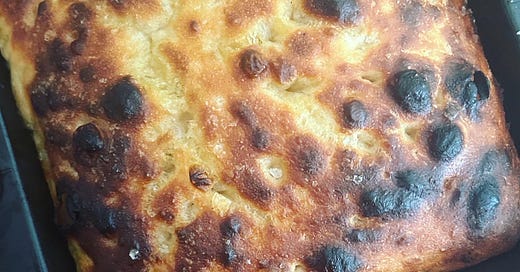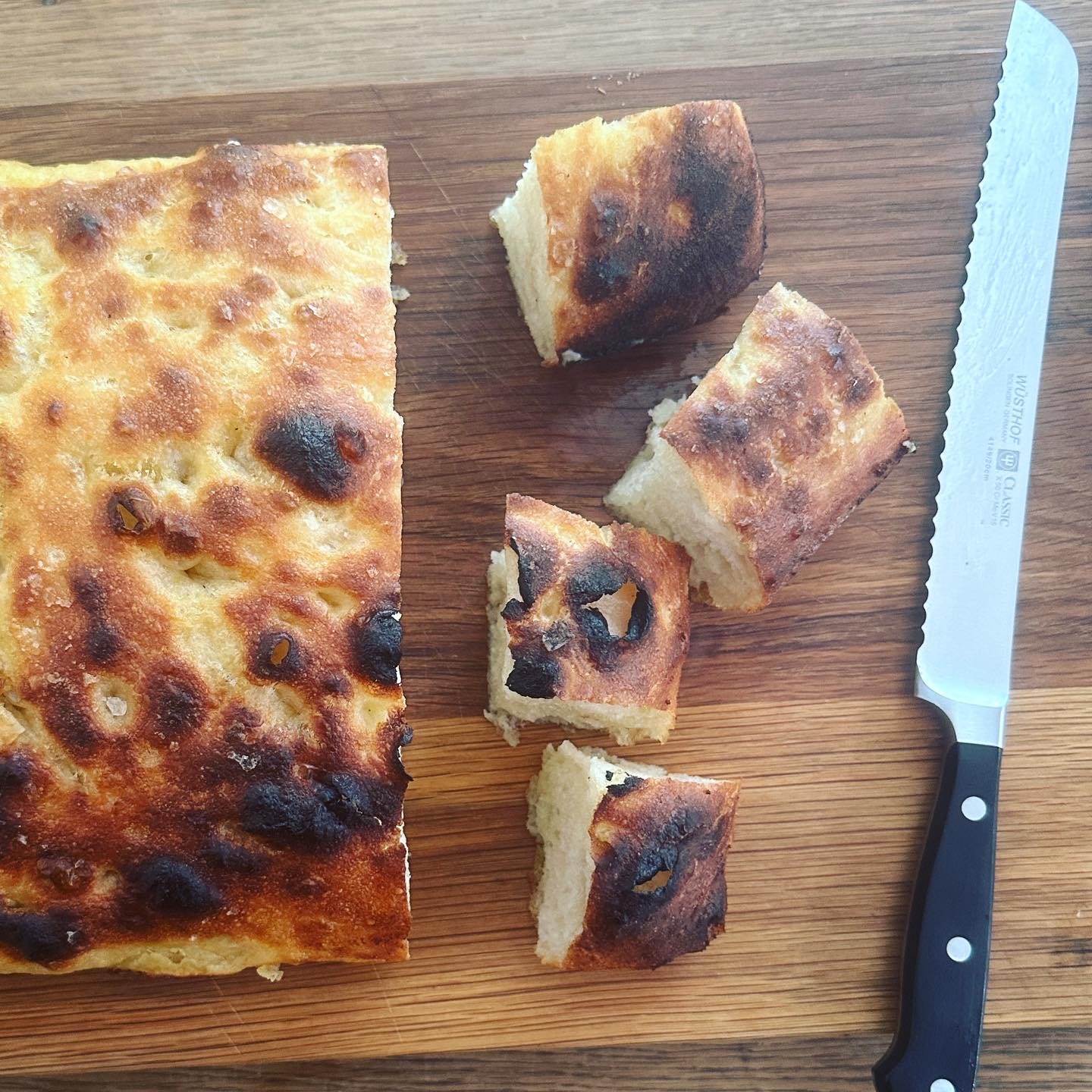In Good Taste #13: Pickle Brine Focaccia
Using leftover brine to make beautiful pillowy bread; fermenting workshop giveaway; Asteroid City
Well, hello there! How are you?
Good I hope. Thank you so much for being here.
I’m feeling a bit ffffff to be honest with you. A bit burnt out and disassociated from myself. I am trying to combat this today by putting on something super colourful, this very bright kimono-style thing that has survived several wardrobe culls, despite that fact I almost never wear it. The look has come out a bit Blithe Spirit but I’m kind of into it.
So. I have two bits of fermenting workshop news that I’m excited to share with you.
Firstly, COMPETITION TIME: you can win a place on my 18th July class at the Dusty Knuckle. The class takes place in the DK shipping container school (next to their Dalston bakery on Abbot St), 6.30-9.30pm. It's a hands-on introduction to the magical process of lacto fermentation. We’ll make sauerkraut, kimchi, seasonal brine pickles and preserved lemons. You’ll leave with a jar of each in a Dusty Knuckle tote bag along with recipes and instructions on how to look after them. But, more importantly, you’ll take away an in-depth knowledge of the science and practicalities of lacto-fermentation and the confidence to pickle anything you fancy.
During the workshop you’ll get to try a variety of vegetable ferments from my own kitchen accompanied by Dusty Knuckle bread and beer from their neighbours at 40ft Brewery. It’s always a fun and friendly evening. The usual price is £85 but one lucky person can come along for absolutely free! All you need to do to enter is comment on my Instagram post before 3pm on Friday and I’ll pick a winner that afternoon.
Secondly, although my summer workshop at the Garden Museum sold out very quickly, I’m really pleased to have been asked to take part in their Branch Out season of free activities. The programme runs all summer with an event, talk or workshop every Thursday and includes all sorts of interesting-looking things including botanical illustration, yoga, and a hands-on minibeast session.
I’ll be running a couple of free workshops during the day on 28th September, teaching people how to concoct their own kraut. It’s free with no booking needed. Do come along!
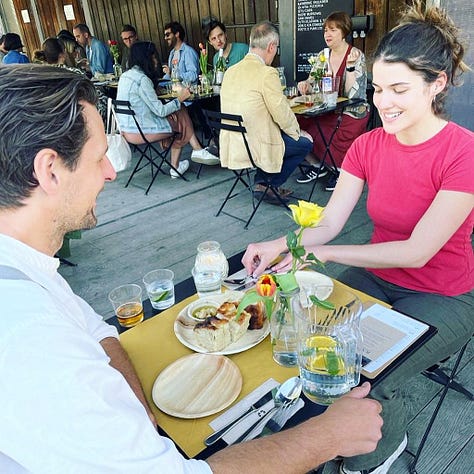
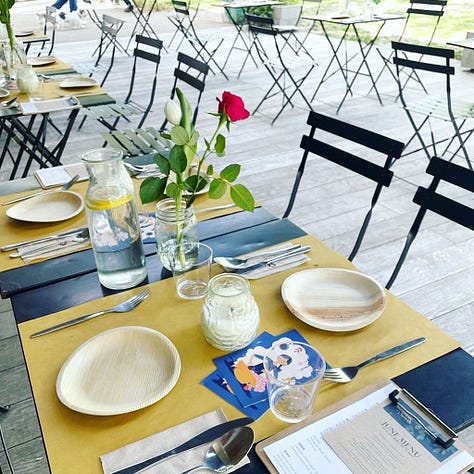
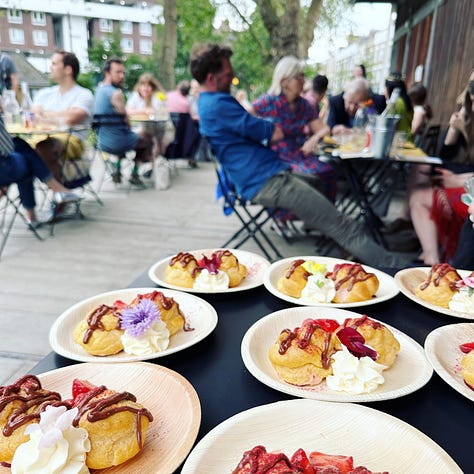
Tickets are also still available for my August supper clubs at Lizzy’s on the Green. They’re £45 each for four courses of sharing plates and include a welcome cocktail. July is sold out and the events have been great fun so far so it would be lovely to see you on either the 5th or 19th August to round out the season.
The August menu is yet to be finalised. It goes without saying that it will be super seasonal and feature some subtle fermented flavours. Probably a greatest hits of this summer and last followed by a showstopper pudding. Newsletter subscribers will be first to hear about it so if you’re not already signed up click the button below so you don’t miss out.
Recipe: Pickle Brine Focaccia
Makes 1 medium sized loaf in an approximately 20cm square tin
This is a focaccia recipe mash up. Years ago (long before I ever started teaching for them myself) I went on a Dusty Knuckle bread course and learned their fluffy-chewy focaccia recipe. It takes a little time as it requires a poolish - a sort of yeasted starter - but is pretty hands off and has never failed me. Then I watched Samin Nosrat make Ligurian focaccia on the Netflix version of Salt, Fat, Acid, Heat, a method which involves pouring brine over the bread as it proves
.
Where there’s brine there’s the opportunity to use pickle brine so I’ve been experimenting with combining ideas from the two recipes. The DK combination of flours gives great chew and squish and the brine helps a crunchy crust develop and adds extra flavour.
Ingredients for the poolish
250g strong white bread flour
250ml tepid water
2g dried yeast
Ingredients for the loaf
Poolish
125g strong white bread flour
125g ‘00’ flour
140ml tepid water
5g dried yeast
10g fine salt
extra virgin olive oil or butter
To finish
80ml pickle brine
2 tbsp extra virgin olive oil
flaky sea salt
Method
Put the ingredients for the poolish in a large bowl and mix until evenly combined. It will be a pretty wet mixture. Cover and leave for 1-2 hours until risen slightly and dotted with bubbles (I once saw these type of bubbles described as ”spider’s eyes” which creeped me out and now I pass that creepiness on to you…).
When the poolish is bubbly and smells yeasty, add the rest of the dough ingredients and mix to combine evenly. It will be a very wet and sticky dough. Once combined, remove from the bowl and knead on a clean work surface for 5 mins. This is best done by stretching it repeatedly up and down as if you are one of those horrible 1950s automata in a baker’s shop window. Stop every now and again to scrape it back together into a ball. I won’t lie to you - this is a bit of an arm workout. You can do it in a stand mixer with a dough hook if you have one. As you knead and the gluten develops, you should feel the dough turn from a wet mess to something with a bit of body and stretch - it will resist you as you stretch it up. Once this has happened, form it into a ball and put it in a generously oiled bowl. Cover with clingfilm and leave for 20 minutes.
Fold the dough. Do this by picking the ball up by its middle - exactly as you were always told not to pick up a cat. Let the ends (the cat’s front and back legs) stretch down into the bowl then allow the middle to collapse onto them. Repeat at right angle to the first stretch then cover again and leave for another 20 minutes.
Do another fold on the dough and then leave for another 20 minutes.
Meanwhile, oil a 20cm square baking tray (a round cake tin will work too) or grease it generously with butter. This might sound weird but because butter contains a small amount of water along with the fat, it creates a thin layer of steam when the bread bakes it means there’s less chance of it sticking to the tin.
Tip the dough out into the oiled tin and gently spread it out. Leave for 20 minutes until it is well risen and puffy then use wet fingers to create dimples. Mix the oil with the brine and carefully pour it over. You want it to sit in the dimples, not at the bottom of the baking pan. Leave it, uncovered for a final 20 minutes.
Meanwhile turn your oven on to 250°C. If you have a pizza stone or steel put it on a shelf about 2/3 up the oven. If not, use another upturned baking tray instead. This is to create heat so the bottom of the loaf bakes thoroughly.
Top the focaccia with a sprinkle of sea salt flakes and bake for 15 mins until golden brown.
Notes
Don’t have any pickle brine, just mix 1 tsp salt into 80ml water (approx a 5% brine) and use that instead. Or use the brine from a jar of olives.
Exact rising times will depend on how warm your kitchen is. Check your dough regularly. Focaccia is a bread that’s better baked over proofed than under so don’t worry about it too much!
Feel free to add any herbs or spices or olives or capers or pickles or vegetables into the bread. Poke them in when you’re dimpling the dough before adding the brine.
Cultural Fun
We went to see Asteroid City the other day and I really enjoyed it. I know lots of people find the highly stylised beauty of Wes Anderson’s films to be at the expense of emotional depth but I think it’s a little more complex than that.
Yes, the exquisitely detailed beauty creates a veneer that separates you from the characters, but I find it moving in and of itself. The story - a film of a fictional 1950s play set at the desert site of a meteor crash - is sort of irrelevant. It’s a series of amusing/unnerving vignettes but even so, in its whimsical way, adds up to a question of what life is really all about. At one point a character asks: “Am I doing it right?” I think we all know how that feels.
I subscribe to the New Yorker. Even though it takes me three weeks to read one issue so I am operating on a constant, ever-increasing, backlog. They send me emails too, pointing out classic pieces from the archives, adding to the list of things I haven’t read. But this week the vintage pick was Malcolm Gladwell’s 2004 exploration of ketchup, which I was already familiar with and is one of my favourites. Ostensibly about tomato sauce it’s really about taste: the sense itself but also the very idea of preference. If you don’t know it (and don’t have stacks of unread magazines cluttering the place up already) I recommend having a look.
Bye! See you next week!
In the meantime, if you felt like sharing In Good Taste with friends or family who might enjoy it, you can do so with the button below. It would mean the world to me. Thanks so much.
In Good Taste is a Sycamore Smyth newsletter by me, Clare Heal.
You can also find me on Instagram or visit my website to find information about my catering work, cookery lessons and upcoming events.


